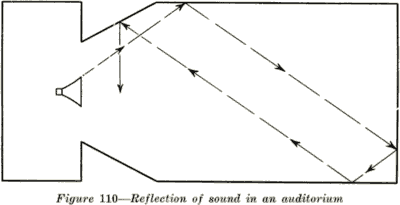159. Echo. -Whenever there is a time lag greater than one-twentieth of a second between two successive
and similar sounds, echo becomes perceptible and annoying, particularly when the echo comes from a
curved surface which concentrates
the sound at the listening point. Translating this time interval in terms of the path difference between
the two sounds, that is, the difference between the total lengths of their paths in traveling from source
to listening point, the path difference should not be greater than 56 feet. Figure 112 shows how this
condition may exist. The path of the reflected ray is 66 + 59 or 125 feet, which is 69 feet longer than the
direct path. The reflected ray, although from a different loudspeaker, can be considered as coming from
the same source.
An echo may sometimes consist of several distinct rapid repetitions of the original sound, in which
case it is called a "multiple" or "flutter" echo. In this case the sound reflects back and forth between the
smooth parallel walls. An echo usually can be distinguished very easily by making a sharp report in the
room such as a hand-clap. When hands are clapped between parallel walls sometimes a dozen or more
successive reflections (flutter echo) can be distinguished. Special sound ray apparatus using a sharp
beam of sound is sometimes found necessary in locating troublesome echoes.

Echo is most generally encountered in large rooms, particularly those with barrel vaulting domes and other smooth curved surfaces. Architectural design often calls for curved
surfaces with radii of curvature equal to the major dimensions of the auditorium, for example, the radius
of curvature for a curved rear wall is usually equal to the length of the room. (See Figure 113.) The effect
of such a surface is to throw the sound back to the source at S1 and create serious echo. Besides, such
a surface, since it concentrates the sound so greatly, gives rise to nonuniform loudness of sound,
forming loud and dead spots.
In general, flat surfaces are to be preferred to curved ones, but curved surfaces of a radius of twice, or
greater than twice, the major dimension of the theatre will not usually give serious trouble. (See Figure
114.)
5
